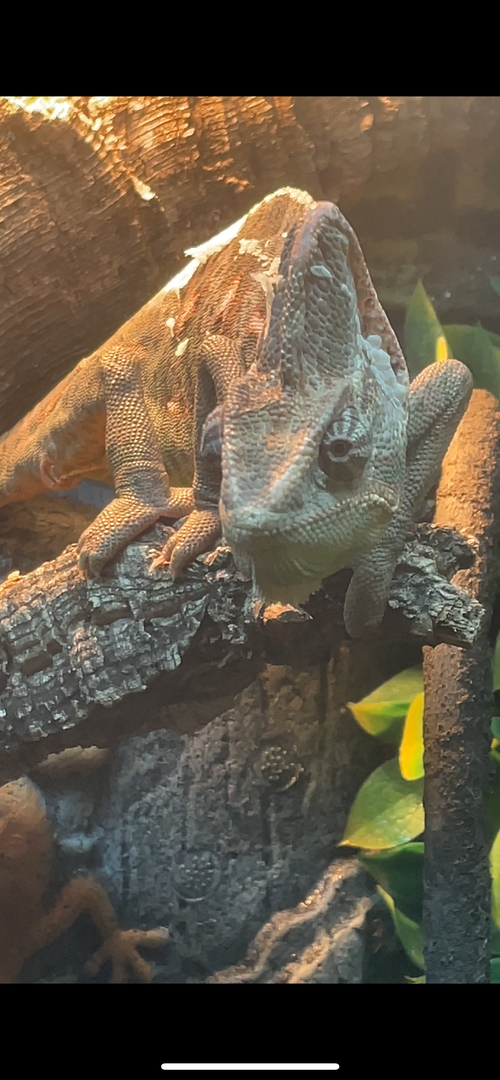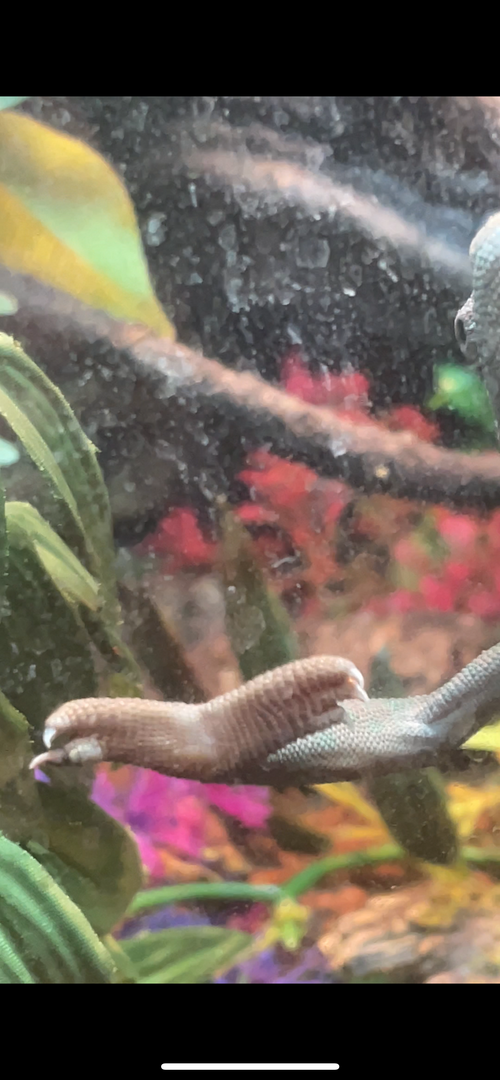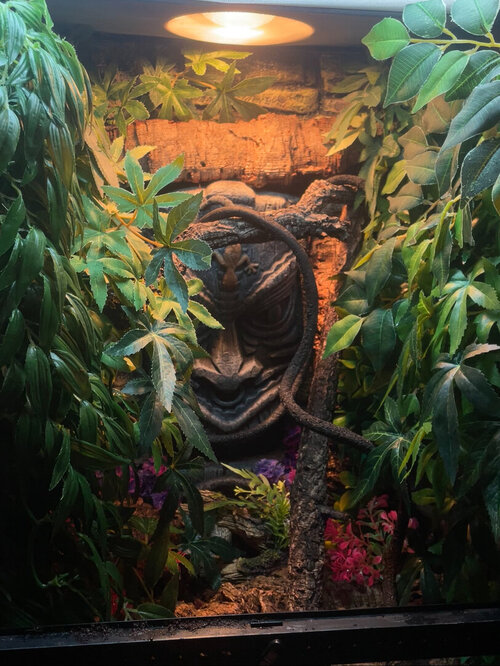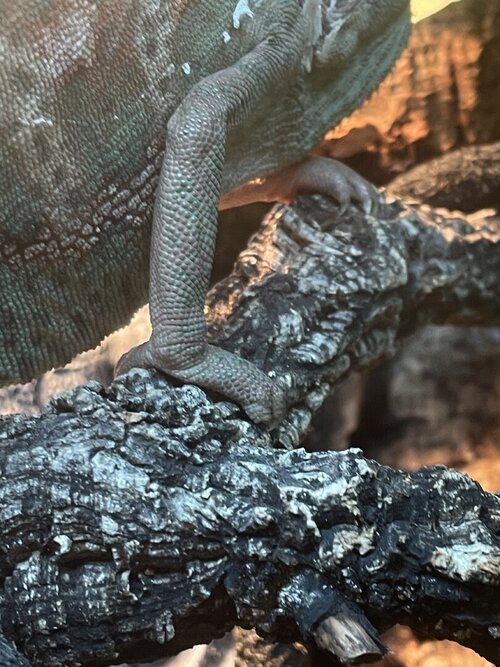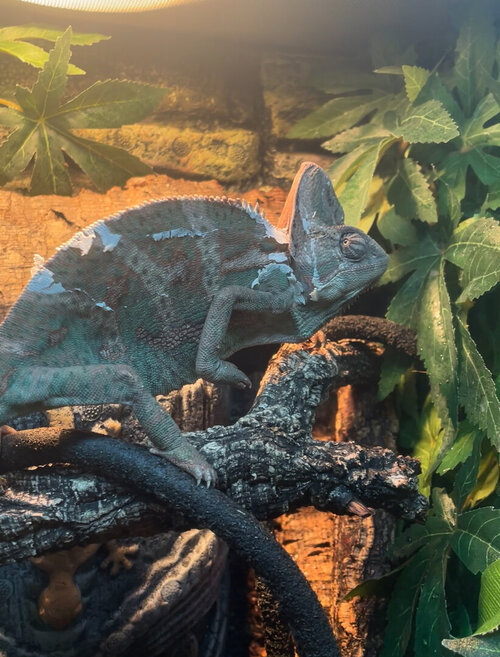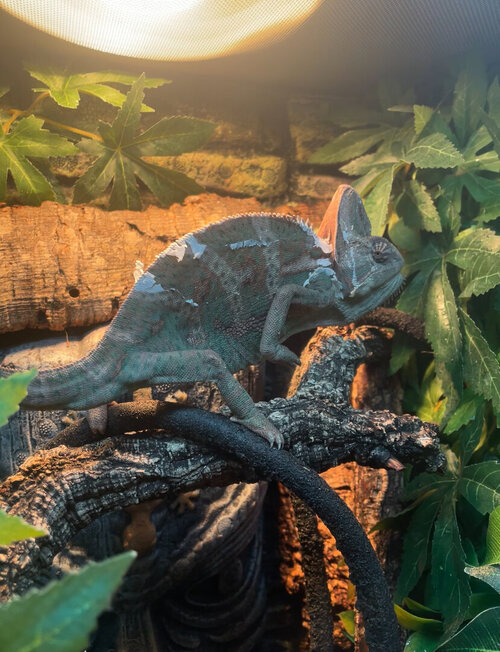hi guys, i put a post on a few weeks ago about my veiled cham and he’s improved so much since i last wrote on here but i’ve been taking him out a couple of times this week and it feels like he couldn’t really grip onto me. i just checked his tiny hands and noticed one of his nails looks pushed back or broken, looking for a second opinion on what to do as i don’t want him to be at risk of an infection. his eating and behaviour, etc is all fine im just concerned for his hand.
Navigation
Install the app
How to install the app on iOS
Follow along with the video below to see how to install our site as a web app on your home screen.
Note: This feature may not be available in some browsers.
More options
You are using an out of date browser. It may not display this or other websites correctly.
You should upgrade or use an alternative browser.
You should upgrade or use an alternative browser.
possible broken nail??
- Thread starter qshleigh
- Start date
hey there. So I see you did make another thread where one of our members tried to help you but you never responded to get help. Everything you mentioned in the other thread were major signs of husbandry issues. So while you are saying he has improved since then my concern would be hiding illness.hi guys, i put a post on a few weeks ago about my veiled cham and he’s improved so much since i last wrote on here but i’ve been taking him out a couple of times this week and it feels like he couldn’t really grip onto me. i just checked his tiny hands and noticed one of his nails looks pushed back or broken, looking for a second opinion on what to do as i don’t want him to be at risk of an infection. his eating and behaviour, etc is all fine im just concerned for his hand.
Per the nail. Yes it looks like he hurt it on something. However there are other concerning things... Like it looks like there is a thermal burn to the top of the casque. This would explain the bulge to the casque if age is correct based on your other thread of being roughly 7 months now. They do not show this kind of fat storage in the casque when they are still under a year old because all food is used for growth. So with thermal burns to the casque you can see this but it ends up actually being infection from the burn.
If you do want help I would post pics of the entire enclosure including the lighting on top and additional pics of the chameleon from all sides. I can also give you the husbandry form to fill out if you like so we can go deeper into the info you were given to ensure it was correct for a chameleon.
This is the other thread…
https://www.chameleonforums.com/threads/looking-for-guidance-on-my-veiled-chameleon.192026/
Please post a couple more photos of your chameleon so we can see all of it from the side and it’s heels too.
https://www.chameleonforums.com/threads/looking-for-guidance-on-my-veiled-chameleon.192026/
Please post a couple more photos of your chameleon so we can see all of it from the side and it’s heels too.
Ever so sorry for the late reply, I’ll try to upload some more photos now, here’s the info from the other post - please let me know if you need anymore.hey there. So I see you did make another thread where one of our members tried to help you but you never responded to get help. Everything you mentioned in the other thread were major signs of husbandry issues. So while you are saying he has improved since then my concern would be hiding illness.
Per the nail. Yes it looks like he hurt it on something. However there are other concerning things... Like it looks like there is a thermal burn to the top of the casque. This would explain the bulge to the casque if age is correct based on your other thread of being roughly 7 months now. They do not show this kind of fat storage in the casque when they are still under a year old because all food is used for growth. So with thermal burns to the casque you can see this but it ends up actually being infection from the burn.
If you do want help I would post pics of the entire enclosure including the lighting on top and additional pics of the chameleon from all sides. I can also give you the husbandry form to fill out if you like so we can go deeper into the info you were given to ensure it was correct for a chameleon.
Chameleon Info:
- Your Chameleon - Jeremy is a veiled chameleon around 7 months old. I’ve had him since mid September of 2023.
- Handling - Typically whenever he feels like coming out, which is either everyday or every other day.
- Feeding - I feed jeremy a diet of crickets and sometimes wax worms as a treat. He also enjoys some fruits or vegetables occasionally such as bananas or tomatoes.
- Supplements - I dust them in prorep botanical calci dust and nutrobal mineral feed for birds and reptiles (this is also serves as a multivitamin).
- Watering - I hand mist or spray jeremy and his enclosure multiple times a day, all to which I see him drinking consistently.
- Fecal Description - Jeremy has never been tested for parasites but all droppings seem perfectly normal. Urine sacks are usually white/ slightly yellowish.
- History - Apart from listed in the description, the top of his enclosure is mesh and he has scraped the top of his veil to the point of it coming off. - I think this is down to him needing a bigger enclosure (which I will be purchasing soon).
Cage Info:
- Cage - Jeremy’s cage is glass vivarium with a mesh top, around / just under 2x2x4.
- Lighting - I use an arcadia t5 12% UVB and an arcadia 100w solar basking floodlight. I make sure I maintain a 12h on & 12 off schedule for jeremy, which usually occurs from 9am to 9pm.
- Temperature - The temperature in his enclosure is usually around 27 - 21, which the temperature cooling more at night.
- Humidity - Jeremy’s humidity often varies between 30s - 55% during the day, and higher percentages of around 70-90% at night.
- Placement - My vivarium* is directly opposite my bed, it is located below an air vent and a few inches away from my window, it rests on a table not too high but not too low from the floor either.
- Location - West Midlands, United Kingdom.
Current Problem - Jeremy’s nail and my previous concerns.
Last edited:
Ever so sorry for the late reply, I’ll try to upload some more photos now, here’s the info from the other post - please let me know if you need anymore.
Chameleon Info:
- Your Chameleon - Jeremy is a veiled chameleon around 7 months old. I’ve had him since mid September of 2023.
- Handling - Typically whenever he feels like coming out, which is either everyday or every other day.
- Feeding - I feed jeremy a diet of crickets and sometimes wax worms as a treat. He also enjoys some fruits or vegetables occasionally such as bananas or tomatoes.
- Supplements - I dust them in prorep botanical calci dust and nutrobal mineral feed for birds and reptiles (this is also serves as a multivitamin).
- Watering - I hand mist or spray jeremy and his enclosure multiple times a day, all to which I see him drinking consistently.
- Fecal Description - Jeremy has never been tested for parasites but all droppings seem perfectly normal. Urine sacks are usually white/ slightly yellowish.
- History - Apart from listed in the description, the top of his enclosure is mesh and he has scraped the top of his veil to the point of it coming off. - I think this is down to him needing a bigger enclosure (which I will be purchasing soon).
Cage Info:
- Cage - Jeremy’s cage is glass vivarium with a mesh top, 2x2x4.
- Lighting - I use an arcadia t5 12% UVB and an arcadia 100w solar basking floodlight. I make sure I maintain a 12h on & 12 off schedule for jeremy, which usually occurs from 9am to 9pm.
- Temperature - The temperature in his enclosure is usually around 27 - 21, which the temperature cooling more at night.
- Humidity - Jeremy’s humidity often varies between 30s - 55% during the day, and higher percentages of around 70-90% at night.
- Placement - My vivarium* is directly opposite my bed, it is located below an air vent and a few inches away from my window, it rests on a table not too high but not too low from the floor either.
- Location - West Midlands, United Kingdom.
Current Problem - Jeremy’s nail and my previous concerns.
these are of jeremy about 10/15 minutes ago, his nail has actually come off now.
(i would like to also add that his lights are still on due to his vivarium having been cleaned out and also for the sake of the photographs being taken. it is currently 11:30, so that’s what time he will be woken tomorrow.)
Attachments
I know @Beman and & @kinyonga can provide better advice but what I see right now is stop feeding tomatoes immediately. The stem and leaves are toxic to chameleons, so just to be safe I wouldn’t feed them. Also, you want your chameleon on a strictly big diet without vegetables. They are insectivores, so stick with that. Also with the UVB, just make sure it is at an appropriate height because that is a strong UVB for that enclosure. I would also try to add in a more diverse diet with BSFL, dubia and maybe some silkworms alongside your crickets.
yungzerk
Chameleon Enthusiast
yes, there will be more experienced people who will chime in but that uvb is waaay too high since you don’t have it raised at all, the recommended uvb is an arcadia %6 since you already have the arcadia brand and i’m sure it’s easier for you to access since you’re in the UK, secondly a 100W light it too hot and your basking spot is probably too far, the recommended wattage is 60. lastly from me since i’m not the most experienced, but you should try to switch up your misting schedule if you’re seeing your guy drink a lot as there’s a theory that chameleons are secretive drinkers. i mist for 3-4 mins 30 mins before lights turn off and on, and an additional 45 seconds- a minute and a half during the daytime if neededI know @Beman and & @kinyonga can provide better advice but what I see right now is stop feeding tomatoes immediately. The stem and leaves are toxic to chameleons, so just to be safe I wouldn’t feed them. Also, you want your chameleon on a strictly big diet without vegetables. They are insectivores, so stick with that. Also with the UVB, just make sure it is at an appropriate height because that is a strong UVB for that enclosure. I would also try to add in a more diverse diet with BSFL, dubia and maybe some silkworms alongside your crickets.
if i was to raise the uvb how high would you suggest? would they be okay if i upsized his viv? he’s only really had vegetables and tomatoes on the off chance so i haven’t given them to him consistently. i’ll definitely look into breaking up his diet and misting him differently to how i do now, his lights have been off for a few hours now but i did mist before i switched them offyes, there will be more experienced people who will chime in but that uvb is waaay too high since you don’t have it raised at all, the recommended uvb is an arcadia %6 since you already have the arcadia brand and i’m sure it’s easier for you to access since you’re in the UK, secondly a 100W light it too hot and your basking spot is probably too far, the recommended wattage is 60. lastly from me since i’m not the most experienced, but you should try to switch up your misting schedule if you’re seeing your guy drink a lot as there’s a theory that chameleons are secretive drinkers. i mist for 3-4 mins 30 mins before lights turn off and on, and an additional 45 seconds- a minute and a half during the daytime if needed
See my feedback in red bold. Please let me know if you have any questions.
Chameleon Info:
Cage Info:
Current Problem - Jeremy’s nail and my previous concerns. per the nail. Keep an eye on the toe.. If it starts swelling then there is infection and a vet will be needed to give antibiotics.
It looks like you just have dirt in the bottom of the enclosure. It does not look like it is done bio active with proper drainage layers and clean up crew. Issue with this is the dirt will start growing bacteria and mold. It will also create stagnant dirty air that he is then breathing in. So you would want to either have a fully bioactive bottom or a bare bottom enclosure.
The fake plants are high risk with veileds they will try to eat them. So if they manage to get pieces off it is an impaction risk. I have added an image that has Veiled tested live plants you can use.
This husbandry program will walk you through everything including set up https://chameleonacademy.com/chameleon-husbandry-program-getting-started-with-chameleons/
This is another great resource of correct information. https://www.youtube.com/@NeptunetheChameleon



Chameleon Info:
- Your Chameleon - Jeremy is a veiled chameleon around 7 months old. I’ve had him since mid September of 2023.
- Handling - Typically whenever he feels like coming out, which is either everyday or every other day.
- Feeding - I feed jeremy a diet of crickets and sometimes wax worms as a treat. He also enjoys some fruits or vegetables occasionally such as bananas or tomatoes. No fruit or veg at all. They are insectivores and their bodies are not able to properly break down fruit or veg. You would feed your insects a gutload of fruit or veg. See image I have attached. These are what you would use for gutloading your insects.
- Supplements - I dust them in prorep botanical calci dust and nutrobal mineral feed for birds and reptiles (this is also serves as a multivitamin). So the prorep calci dust can be used as the regular calcium without D3. It would be used at all feedings very lightly dusted on the insects prior to feeding. Then the Nutrobal would be the multivitamin with D3 and A. These are both fat soluble vitamins so they store in the body. You only want to used this at 2 feedings a month say the 1st and the 15th very lightly dusted on the insects.
- Watering - I hand mist or spray jeremy and his enclosure multiple times a day, all to which I see him drinking consistently.
- Fecal Description - Jeremy has never been tested for parasites but all droppings seem perfectly normal. Urine sacks are usually white/ slightly yellowish.
- History - Apart from listed in the description, the top of his enclosure is mesh and he has scraped the top of his veil to the point of it coming off. - I think this is down to him needing a bigger enclosure (which I will be purchasing soon). I think he also had a thermal burn to the top of the casque based on the overall appearance and the heat wattage being used in combination with how close he is to the heat fixture.
Cage Info:
- Cage - Jeremy’s cage is glass vivarium with a mesh top, around / just under 2x2x4. So based on the images I think the enclosure is much smaller than you realize. They need a minimum of 24x24x48 inches tall. Yours looks quite a bit shorter than that. This really needs to be done soon because he has totally outgrown this one.
- Lighting - I use an arcadia t5 12% UVB and an arcadia 100w solar basking floodlight. I make sure I maintain a 12h on & 12 off schedule for jeremy, which usually occurs from 9am to 9pm. So for this boy you want a 6% UVB bulb. The 12% is much too strong of a UVI output especially at the distance he is to it. He would be in overexposure levels. With the 12% you want a full 11-12 inches from the bottom of the fixture to the branch. With a 6% bulb you need 8-9 inches from the bottom of the fixture to the branch. For basking the 100 watt basking light would produce far too high of heat. Also extremely high risk of thermal burn to casque and spine. I would drop this back to a standard 60-75 watt regular white incandescent bulb. Or raise that 100 watt fixture up off the top of the cage 4-5 inches then use a temp gauge that has a probe at the branch to see what temps it is pulling. Keep in mind if it is saying 85 at the branch then it would be reaching temps of 88-89 at spine and casque.
- Temperature - The temperature in his enclosure is usually around 27 - 21, which the temperature cooling more at night. So ambient temps for daytime should be more around the 21. Basking temp should be 26-29 max this would be at the back. At night you want to be able to drop temps down into the 15-20 range. They need the cool down.
- Humidity - Jeremy’s humidity often varies between 30s - 55% during the day, and higher percentages of around 70-90% at night. These number are fine for day... At night need temps lower though for this high of humidity. there is a risk of respiratory infection when humidity is high and temps are still in 70's.
- Placement - My vivarium* is directly opposite my bed, it is located below an air vent and a few inches away from my window, it rests on a table not too high but not too low from the floor either. Make sure the air vent is not directly blowing into the cage.
- Location - West Midlands, United Kingdom.
Current Problem - Jeremy’s nail and my previous concerns. per the nail. Keep an eye on the toe.. If it starts swelling then there is infection and a vet will be needed to give antibiotics.
It looks like you just have dirt in the bottom of the enclosure. It does not look like it is done bio active with proper drainage layers and clean up crew. Issue with this is the dirt will start growing bacteria and mold. It will also create stagnant dirty air that he is then breathing in. So you would want to either have a fully bioactive bottom or a bare bottom enclosure.
The fake plants are high risk with veileds they will try to eat them. So if they manage to get pieces off it is an impaction risk. I have added an image that has Veiled tested live plants you can use.
This husbandry program will walk you through everything including set up https://chameleonacademy.com/chameleon-husbandry-program-getting-started-with-chameleons/
This is another great resource of correct information. https://www.youtube.com/@NeptunetheChameleon
yungzerk
Chameleon Enthusiast
thank you for taking the time to do this bemanSee my feedback in red bold. Please let me know if you have any questions.
Chameleon Info:
- Your Chameleon - Jeremy is a veiled chameleon around 7 months old. I’ve had him since mid September of 2023.
- Handling - Typically whenever he feels like coming out, which is either everyday or every other day.
- Feeding - I feed jeremy a diet of crickets and sometimes wax worms as a treat. He also enjoys some fruits or vegetables occasionally such as bananas or tomatoes. No fruit or veg at all. They are insectivores and their bodies are not able to properly break down fruit or veg. You would feed your insects a gutload of fruit or veg. See image I have attached. These are what you would use for gutloading your insects.
- Supplements - I dust them in prorep botanical calci dust and nutrobal mineral feed for birds and reptiles (this is also serves as a multivitamin). So the prorep calci dust can be used as the regular calcium without D3. It would be used at all feedings very lightly dusted on the insects prior to feeding. Then the Nutrobal would be the multivitamin with D3 and A. These are both fat soluble vitamins so they store in the body. You only want to used this at 2 feedings a month say the 1st and the 15th very lightly dusted on the insects.
- Watering - I hand mist or spray jeremy and his enclosure multiple times a day, all to which I see him drinking consistently.
- Fecal Description - Jeremy has never been tested for parasites but all droppings seem perfectly normal. Urine sacks are usually white/ slightly yellowish.
- History - Apart from listed in the description, the top of his enclosure is mesh and he has scraped the top of his veil to the point of it coming off. - I think this is down to him needing a bigger enclosure (which I will be purchasing soon). I think he also had a thermal burn to the top of the casque based on the overall appearance and the heat wattage being used in combination with how close he is to the heat fixture.
Cage Info:
- Cage - Jeremy’s cage is glass vivarium with a mesh top, around / just under 2x2x4. So based on the images I think the enclosure is much smaller than you realize. They need a minimum of 24x24x48 inches tall. Yours looks quite a bit shorter than that. This really needs to be done soon because he has totally outgrown this one.
- Lighting - I use an arcadia t5 12% UVB and an arcadia 100w solar basking floodlight. I make sure I maintain a 12h on & 12 off schedule for jeremy, which usually occurs from 9am to 9pm. So for this boy you want a 6% UVB bulb. The 12% is much too strong of a UVI output especially at the distance he is to it. He would be in overexposure levels. With the 12% you want a full 11-12 inches from the bottom of the fixture to the branch. With a 6% bulb you need 8-9 inches from the bottom of the fixture to the branch. For basking the 100 watt basking light would produce far too high of heat. Also extremely high risk of thermal burn to casque and spine. I would drop this back to a standard 60-75 watt regular white incandescent bulb. Or raise that 100 watt fixture up off the top of the cage 4-5 inches then use a temp gauge that has a probe at the branch to see what temps it is pulling. Keep in mind if it is saying 85 at the branch then it would be reaching temps of 88-89 at spine and casque.
- Temperature - The temperature in his enclosure is usually around 27 - 21, which the temperature cooling more at night. So ambient temps for daytime should be more around the 21. Basking temp should be 26-29 max this would be at the back. At night you want to be able to drop temps down into the 15-20 range. They need the cool down.
- Humidity - Jeremy’s humidity often varies between 30s - 55% during the day, and higher percentages of around 70-90% at night. These number are fine for day... At night need temps lower though for this high of humidity. there is a risk of respiratory infection when humidity is high and temps are still in 70's.
- Placement - My vivarium* is directly opposite my bed, it is located below an air vent and a few inches away from my window, it rests on a table not too high but not too low from the floor either. Make sure the air vent is not directly blowing into the cage.
- Location - West Midlands, United Kingdom.
Current Problem - Jeremy’s nail and my previous concerns. per the nail. Keep an eye on the toe.. If it starts swelling then there is infection and a vet will be needed to give antibiotics.
It looks like you just have dirt in the bottom of the enclosure. It does not look like it is done bio active with proper drainage layers and clean up crew. Issue with this is the dirt will start growing bacteria and mold. It will also create stagnant dirty air that he is then breathing in. So you would want to either have a fully bioactive bottom or a bare bottom enclosure.
The fake plants are high risk with veileds they will try to eat them. So if they manage to get pieces off it is an impaction risk. I have added an image that has Veiled tested live plants you can use.
This husbandry program will walk you through everything including set up https://chameleonacademy.com/chameleon-husbandry-program-getting-started-with-chameleons/
This is another great resource of correct information. https://www.youtube.com/@NeptunetheChameleon
View attachment 352194View attachment 352195View attachment 352196
elizaann2
Chameleon Enthusiast
Don't feel stupid, we all started somewhere.thank you for taking the time to do this beman, i felt a little bit stupid trying to help

Help in threads where you can... if needed tag others for additional help. That is all we can ask for here.thank you for taking the time to do this beman, i felt a little bit stupid trying to help

elizaann2
Chameleon Enthusiast
For the record that’s what I doHelp in threads where you can... if needed tag others for additional help. That is all we can ask for here.

